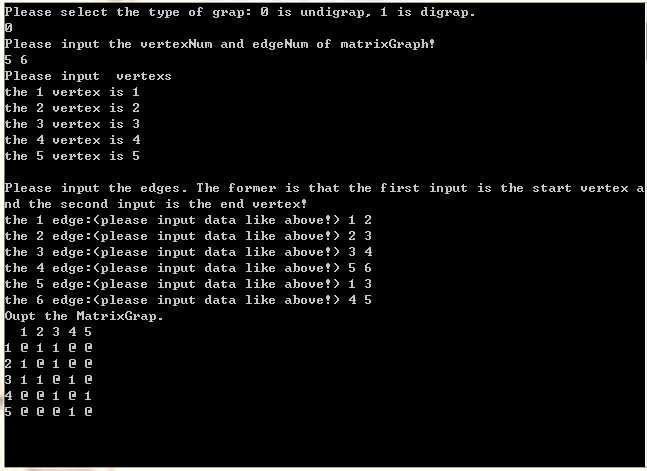标签:
1、定义图的链接矩阵:
1 #define VERTEX_MAX 6 2 #define MAXVALUE 32767 3 typedef struct{ 4 int vertex[VERTEX_MAX]; 5 int edges[VERTEX_MAX][VERTEX_MAX]; 6 int vertexNum,edgesNum; 7 int grapType; 8 }MatrixGraph;
2、定义函数createGraph,创建图的邻接矩阵:
1 void createGraph(MatrixGraph *g){ 2 int start,end; 3 printf("Please input vertexs\n"); 4 for(int i=0;i<g->vertexNum;i++){ 5 printf("the %d vertex is ",i+1); 6 scanf("%d",&g->vertex[i]); 7 } 8 printf("\nPlease input the edges. The former is that the first input is the start vertex and the second input is the end vertex!\n"); 9 for(int i=0;i<g->edgesNum;i++){ 10 printf("the %d edge:(please input data like above!) ",i+1); 11 scanf("%d%d",&start,&end); 12 g->edges[start-1][end-1]=1; 13 if(g->grapType==0) 14 g->edges[end-1][start-1]=1; 15 } 16 }
3、定义函数输出邻居矩阵的内容:
1 void printGraph(MatrixGraph *g){ 2 printf(" "); 3 for(int i=0;i<g->vertexNum;i++){ 4 printf("%d ",g->vertex[i]); 5 } 6 for(int i=0;i<g->vertexNum;i++){ 7 printf("\n%d ",g->vertex[i]); 8 for(int j=0;j<g->vertexNum;j++){ 9 if(g->edges[i][j]==MAXVALUE) 10 printf("@ "); 11 else 12 printf("%d ",g->edges[i][j]); 13 } 14 } 15 printf("\n"); 16 }
4、主函数:
1 int main(){ 2 MatrixGraph *g; 3 g=(MatrixGraph *)malloc(sizeof(MatrixGraph)); 4 printf("Please select the type of grap: 0 is undigrap, 1 is digrap.\n"); 5 scanf("%d",&g->grapType); 6 printf("Please input the vertexNum and edgeNum of matrixGraph!\n"); 7 scanf("%d%d",&g->vertexNum,&g->edgesNum); 8 for(int i=0;i<g->vertexNum;i++){ 9 for(int j=0;j<g->vertexNum;j++){ 10 g->edges[i][j]=MAXVALUE; 11 } 12 } 13 createGraph(g); 14 printf("Oupt the MatrixGrap. \n"); 15 printGraph(g); 16 free(g); 17 getch(); 18 return 0; 19 }
注意:主函数中的
MatrixGraph *g;
可以改写成
MatrixGraph g;
1 printf("Please select the type of grap: 0 is undigrap, 1 is digrap.\n"); 2 scanf("%d",&g.grapType); 3 printf("Please input the vertexNum and edgeNum of matrixGraph!\n"); 4 scanf("%d%d",&g.vertexNum,&g.edgesNum); 5 for(int i=0;i<g.vertexNum;i++){ 6 for(int j=0;j<g.vertexNum;j++){ 7 g.edges[i][j]=MAXVALUE; 8 } 9 } 10 createGraph(&g); 11 printf("Oupt the MatrixGrap. \n"); 12 printGraph(&g); 13 getch(); 14 return 0;
但是后面指向结构体变量时需要用 . 而不是用->,并且需要给结构体指针变量先开辟空间 。
在c++中g如果是对象,就可以通过"."来调用I中的成员变量。
如果g是指针的话,就不能通过"."来调用,而只能使用"->"来调用。
在C语言中不存在对象的概念。
这种情况的出现是因为使用了结构,例如:
在程序中
1 MatrixGraph G;
我们就可以用G.vertexNum来取得结构中的值。
这时是不能使用"->"来调用的,"->"符号指针对指针来说的。
如下情况可以使用"->"
1 MatrixGraph *g;
此时g为一个MatrixGraph结构的地址指针。所以可以使用"->",而此时就不能使用
"."来操作。因为"." "相当于"对象的成员调用。
最终显示结果:


标签:
原文地址:http://www.cnblogs.com/hoojjack/p/4563017.html